A Return to Terry Carr’s Best Science Fiction of the Year
My taste in science fiction — like my taste in music and film — was shaped early. What I learned to love as a teen I largely still enjoy… with some exceptions. One of those exceptions is Terry Carr’s Best Science Fiction of the Year. I picked up my first one in 1977, at the age of 13, and I discovered pretty quickly that they weren’t for me. I went back to reading pulp SF in books like Before the Golden Age, and was blissfully happy to do so for many years.
I’ve returned to Carr’s Best Science Fiction of the Year recently, and discovered why I didn’t connect with them four decades ago: unlike many of his contemporaries, Carr brought an adult eye to SF, and the fiction he selected spoke to adults. It still speaks to adults today, clearly and with no loss of voice, and I now consider Carr’s Best volumes — especially the ones he did in the mid-70s — to be some some of the best SF anthologies ever printed. Here’s what I said last year about #3, published in 1973.
How incredible was The Best Science Fiction of the Year #3? It contains some of the finest science fiction stories of all time, packed into one slender volume. Like “The Women Men Don’t See” by James Tiptree, Jr… perhaps her most famous story, and that’s saying something. And Vonda N. McIntyre’s Nebula Award-winning “Of Mist, and Grass, and Sand,” which became the basis of her 1978 novel Dreamsnake (which swept the Hugo, Nebula, and Locus Awards the following year.) And Harlan Ellison’s classic “The Deathbird,” the Hugo and Locus Award-winning title story of his celebrated 1975 collection Deathbird Stories. Plus Gene Wolfe’s famous “The Death of Dr. Island,” winner of the Locus and Nebula awards for Best Novella.
And an unassuming little story by a young writer named Ursula K. Le Guin, “The Ones Who Walk Away from Omelas,” which won the Hugo Award for Best Short Story, and is considered by many (me included) to be one of the finest short stories ever written. And lots more — including a Jack Vance novella, plus stories by Philip José Farmer, Alfred Bester, R. A. Lafferty, Robert Silverberg, and F. M. Busby. All for $1.50!
Last month I purchased a fine collection of six Best Science Fiction of the Year volumes (pictured above) on eBay for the criminally low price of $7. They arrived a few weeks ago, and I’ve stolen a few minutes here and there to dip into them. It’s been an enormously rewarding experience.
[Click the images for bigger versions.]
There’s no doubt that Carr had a nose for award winners. Unlike modern Best SF annuals, like Rich Horton’s Year’s Best Science Fiction & Fantasy and Gardner Dozois’s massive Year’s Best Science Fiction, both 500+ page trade paperbacks, these slender 300-page mass market paperbacks had a very tight word count. Nonetheless, Carr managed to ferret out many of the most acclaimed short stories of the year. The six volumes above contain 73 stories, including:
- 19 Hugo nominees, and 7 Hugo Award winners
- 17 Nebula nominees, and 5 Nebula Award winners
- 8 Locus Award winners
- 10 novellas, from Gene Wolfe, Joe Haldeman, Jack Vance, Algis Budrys, George R. R. Martin, Lisa Tuttle, Spider Robinson and Jeanne Robinson, and Vonda N. McIntyre
Of course, since most of these books appeared in July, two months before the Hugo awards, it’s fair to question whether Carr was predicting or directly influencing vote counts. Nonetheless, he did include a disproportionately large percentage of major award earners every year.
The series was launched by Ballantine Books. The first three were released with cover art; Volume #4 was the first to adopt the uniform color design that became the series trademark. In 1976 Ballantine reprinted the first three volumes with new covers matching the rest of the series; those are the ones you see above.
With Volume 10 the series moved to Timescape/Pocket Books for three years (1981-83); in 1984 Baen picked up the series for a single volume. It finally settled at Tor from 1985-87. The sixteenth and final volume was only published in hardcover in the US; Gollancz did release a paperback edition in the UK.
Here’s a closer look at each of the six volumes above.
The Best Science Fiction of the Year #2
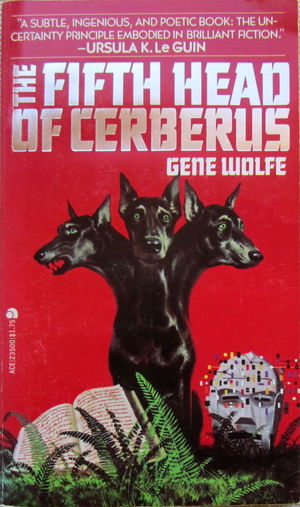 (381 pages, $1.95, July 1973) — 16 stories
(381 pages, $1.95, July 1973) — 16 stories
One of the strongest volumes in a very strong decade, this one crammed in no less than sixteen stories (nearly a record), while still managing to include two novellas by Gene Wolfe and Joe Haldeman.
Standouts include Wolfe’s “The Fifth Head of Cerberus,” perhaps his most famous story, and Fred Pohl and C. M. Kornbluth’s classic tale “The Meeting,” about the parents of a disabled child being given an almost impossible choice.
Honorable Mentions – 1972
Introduction by Terry Carr
“The Meeting” by Frederik Pohl and C. M. Kornbluth (The Magazine of Fantasy and Science Fiction, November 1972) — Hugo Winner, Best Novelette
“Nobody’s Home” by Joanna Russ (New Dimensions II)
“Fortune Hunter” by Poul Anderson (Infinity Four)
“The Fifth Head of Cerberus” by Gene Wolfe (Orbit 10) — Hugo & Nebula nominee, Best Novella
“Caliban” by Robert Silverberg (Infinity Three)
“Conversational Mode” by Grahame Leman (New Writings in SF—20)
“Their Thousandth Season” by Edward Bryant (Clarion II)
“Eurema’s Dam” by R. A. Lafferty (New Dimensions II) — Hugo winner, Best Short Story
“Zero Gee” by Ben Bova (Again, Dangerous Visions)
“Sky Blue” by Alexei Panshin and Cory Panshin (Amazing Science Fiction, March 1972)
“Miss Omega Raven” by Naomi Mitchison (Nova 2)
“Patron of the Arts” by William Rotsler (Universe 2) — Hugo & Nebula nominee, Best Novelette
“Grasshopper Time” by Gordon Eklund (The Magazine of Fantasy and Science Fiction, March 1972)
“Hero” by Joe Haldeman (Analog Science Fiction/Science Fact, June 1972)
“When We Went to See the End of the World” by Robert Silverberg (Universe 2) — Hugo & Nebula nominee, Best Novelette
“Painwise” by James Tiptree, Jr. (The Magazine of Fantasy and Science Fiction, February 1972) — Hugo nominee, Best Novelette
The Best Science Fiction of the Year #3
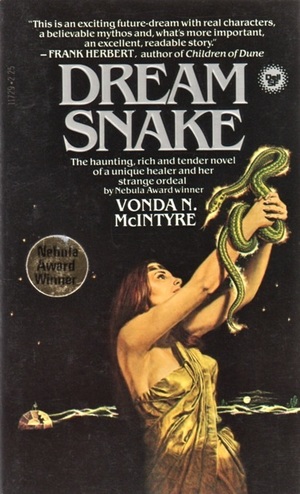 (379 pages, $1.95, July 1974) — 11 stories
(379 pages, $1.95, July 1974) — 11 stories
The Best Science Fiction of the Year #3 is one of the finest science fiction anthologies of the 20th Century. It contains 9 stories and two novellas by Gene Wolfe and Jack Vance.
An interesting aspect of this volume (and the preceding one) was that they drew almost exclusively from original anthologies, rather than magazines. If you were a short fiction fan in the mid-70s, anthologies were where it was at.
Vonda N. McIntyre’s Nebula-winning “Of Mist, and Grass, and Sand” was eventually expanded with two additional novelettes, “The Broken Dome” and “The Serpent’s Death,” both of which appeared in Analog in 1978. A fix-up novel containing all three, Dreamsnake (1978) swept the Locus, Nebula and Hugo awards for Best Novel.
Introduction by Terry Carr
“Something Up There Likes Me” by Alfred Bester (Astounding: John W. Campbell Memorial Anthology)
“The World as Will and Wallpaper” by R. A. Lafferty (Future City)
“Breckenridge and the Continuum” by Robert Silverberg (Showcase)
“Rumfuddle” by Jack Vance (Three Trips in Time and Space: Original Novellas of Science Fiction)
“Tell Me All About Yourself” by F. M. Busby (New Dimensions 3)
“The Deathbird” by Harlan Ellison (The Magazine of Fantasy and Science Fiction, March 1973) — Nebula nominee, Hugo and Locus Award winner, Best Novelette
“Of Mist, and Grass, and Sand” by Vonda N. McIntyre (Analog Science Fiction/Science Fact, October 1973) — Hugo and Locus Award nominee, Nebula Winner, Best Novelette
“The Death of Dr. Island” by Gene Wolfe (Universe 3) — Hugo nominee, Nebula and Locus Award winner, Best Novella
“The Ones Who Walk Away from Omelas” by Ursula K. Le Guin (New Dimensions 3) — Hugo Award, Best Short Story
“Sketches Among the Ruins of My Mind” by Philip José Farmer (Nova 3)
“The Women Men Don’t See” by James Tiptree, Jr. (The Magazine of Fantasy and Science Fiction, December 1973)
Honorable Mentions – 1973
The Best Science Fiction of the Year #5
(378 pages, $1.95, July 1976) — 12 stories
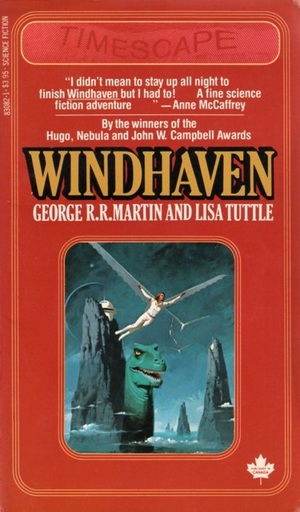 Starting in volume 4 in 1975, Locus editor Charles Brown began contributing an annual summation, “The Science Fiction Year,” helping to round out a book that called itself The Best Science Fiction of the Year with needed coverage of novels, collections, and films. It was a tradition that has carried on since, perfected by Gardner Dozois’ annual 60-page summations in his Year’s Best Science Fiction.
Starting in volume 4 in 1975, Locus editor Charles Brown began contributing an annual summation, “The Science Fiction Year,” helping to round out a book that called itself The Best Science Fiction of the Year with needed coverage of novels, collections, and films. It was a tradition that has carried on since, perfected by Gardner Dozois’ annual 60-page summations in his Year’s Best Science Fiction.
Volume 5 included an Instrumentality of Mankind novelette by Cordwainer Smith, a Space War Blues story by Richard A. Lupoff, a Locus Award-winning Windhaven novella by George R. R. Martin and Lisa Tuttle, and a Hugo-nominated novella by Algis Budrys.
Introduction by Terry Carr
“Down to a Sunless Sea” by Cordwainer Smith (The Magazine of Fantasy and Science Fiction, October 1975)
“Retrograde Summer” by John Varley (The Magazine of Fantasy and Science Fiction, February 1975) — Nebula nominee
“The Hero as Werwolf” by Gene Wolfe (The New Improved Sun)
“The Silent Eyes of Time” by Algis Budrys (The Magazine of Fantasy and Science Fiction, November 1975) — Hugo Nominee
“Croatoan” by Harlan Ellison (The Magazine of Fantasy and Science Fiction, May 1975) — Hugo nominee, Locus Award winner, Best Short Story
“Doing Lennon” by Gregory Benford (Analog Science Fiction/Science Fact, April 1975) — Hugo and Nebula nominee
“The New Atlantis” by Ursula K. Le Guin (The New Atlantis and Other Novellas of Science Fiction) — Hugo and Nebula nominee, Locus Award winner, Best Novelette
“Clay Suburb” by Robert F. Young (Amazing Science Fiction, November 1975)
“The Storms of Windhaven” by George R. R. Martin and Lisa Tuttle (Analog Science Fiction/Science Fact, May 1975) — Nebula and Hugo nominee, Locus Award winner, Best Novella
“Child of All Ages” by P. J. Plauger (Analog Science Fiction/Science Fact, March 1975) — Hugo and Nebula nominee
“In the Bowl” by John Varley (The Magazine of Fantasy and Science Fiction, December 1975) — Nebula nominee
“Sail the Tide of Mourning” by Richard A. Lupoff (New Dimensions 5) — Hugo and Nebula nominee
Recommended Reading – 1975
The Science Fiction Year (1975) by Charles N. Brown
Here’s a look at the back covers (click for bigger versions).
The Best Science Fiction of the Year #6
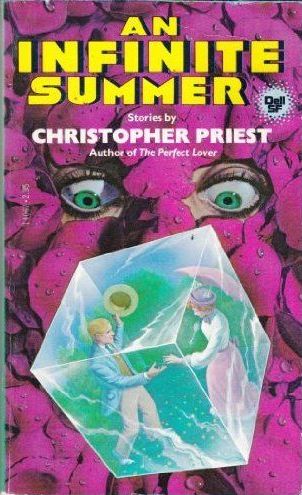 (399 pages, $1.95, July 1977) — 11 stories
(399 pages, $1.95, July 1977) — 11 stories
The Best Science Fiction of the Year #6 was the first one of the series I read — and man, at the time I really didn’t like it. Damon Knight’s “I See You,” about a guy who invents a machine that gives everyday citizens access to all the secrets of history (and, incidentally, all their neighbors secrets) was nifty enough to my 13-year old eyes. John Varley’s “The Phantom of Kansas,” about a man who has sex with his clone, and George R.R. Martin’s “Meathouse Man,” featuring a zombie whorehouse, certainly blew back my eyelids, but beyond the (rather icky) titillation factor, the stories really didn’t move me.
Much better was Asimov’s “The Bicentennial Man,” which swept the Hugo, Nebula, and Locus awards that year, but it wasn’t enough to redeem the book in my young eyes.
The only novella in this volume was Gene Wolfe’s Nebula and Locus nominee “The Eyeflash Miracles.” Christopher Priest’s “The Infinite Summer” was included in his 1979 collection of the same name.
Introduction by Terry Carr
“I See You” by Damon Knight (The Magazine of Fantasy and Science Fiction, November 1976) — Hugo and Locus Award nominee
“The Phantom of Kansas” by John Varley (Galaxy, February 1976) — Hugo and Locus Award nominee
“Seeing” by Harlan Ellison (Andromeda I)
“The Death of Princes” by Fritz Leiber (Amazing Science Fiction, June 1976)
“The Psychologist Who Wouldn’t Do Awful Things to Rats” by James Tiptree, Jr. (New Dimensions 6)
“The Eyeflash Miracles” by Gene Wolfe (Future Power) — Nebula and Locus Award nominee
“An Infinite Summer” by Christopher Priest (Andromeda I)
“The Highest Dive” by Jack Williamson (Science Fiction Monthly, January 1976)
“Meathouse Man” by George R. R. Martin (Orbit 18)
“Custer’s Last Jump” by Steven Utley and Howard Waldrop (Universe 6) — Nebula and Locus Award nominee
“The Bicentennial Man” by Isaac Asimov (Stellar #2) — Hugo, Nebula and Locus Award winner, Best Novelette
Recommended Reading – 1976
The Science Fiction Year (1976) by Charles N. Brown
The Best Science Fiction of the Year #7
(377 pages, $1.95, July 1978) — 9 stories
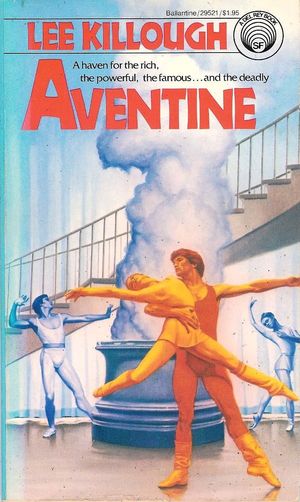 Volume 7 contains three novellas, including Spider and Jeanne Robinson’s famous “Stardance,” about a woman who communicates with aliens through dance. It swept the Hugo, Nebula, and Locus awards, and was eventually turned into a novel.
Volume 7 contains three novellas, including Spider and Jeanne Robinson’s famous “Stardance,” about a woman who communicates with aliens through dance. It swept the Hugo, Nebula, and Locus awards, and was eventually turned into a novel.
Vonda N. McIntyre’s “Aztecs” was a nominee for all three awards; Lisa Tuttle’s “The Family Monkey” is the third novella.
The book also contains Lee Killough’s Aventine tale “Tropic of Eden,” one his tales about an interplanetary resort.
Introduction by Terry Carr
“Lollipop and the Tar Baby” by John Varley (Orbit 19)
“Stardance” by Spider Robinson and Jeanne Robinson (Analog Science Fiction/Science Fact, March 1977) — Hugo, Nebula and Locus Award winner, Best Novella
“The House of Compassionate Sharers” by Michael Bishop (Cosmos Science Fiction and Fantasy, May 1977)
“The Screwfly Solution” by by Raccoona Sheldon (James Tiptree, Jr.) (Analog Science Fiction/Science Fact, June 1977) — Hugo and Locus nominee, Nebula winner, Best Novelette
“Aztecs” by Vonda N. McIntyre (2076: The American Tricentennial) — Hugo, Nebula and Locus Award nominee, Best Novella
“Tropic of Eden” by Lee Killough (The Magazine of Fantasy and Science Fiction, August 1977)
“Victor” by Bruce McAllister (The Magazine of Fantasy and Science Fiction, July 1977)
“The Family Monkey” by Lisa Tuttle (New Voices in Science Fiction)
“A Rite of Spring” by Fritz Leiber (Universe 7) — Nebula and Locus nominee
Recommended Reading – 1977
The Science-Fiction Year (1977) by Charles N. Brown
The Best Science Fiction of the Year #9
(380 pages, $2.50, August 1980) — 14 stories
In 1979 and 1980, Carr convinced his editors at Del Rey to let him produce a separate volume of Best Science Fiction Novellas — I covered both volumes here last month.
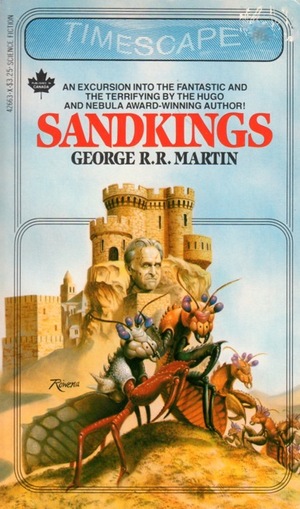 It was a noble experiment that only lasted two years. But during those years, short ficiton no longer had to compete with novellas in Carr’s volumes, giving him a lot more room to breathe. The result was a much wider selection — 14 stories in the case of #9, including George R.R. Martins’ brilliant SF horror story “Sandkings,” one of the best science fiction stories of the 20th Century.
It was a noble experiment that only lasted two years. But during those years, short ficiton no longer had to compete with novellas in Carr’s volumes, giving him a lot more room to breathe. The result was a much wider selection — 14 stories in the case of #9, including George R.R. Martins’ brilliant SF horror story “Sandkings,” one of the best science fiction stories of the 20th Century.
Also included are Vonda McIntyre’s “Fireflood,” and one of Philip K. Dick’s last short stories (he died in 1982).
Introduction by Terry Carr
“Galatea Galante, The Perfect Popsy” by Alfred Bester (Omni, April 1979)
“Sandkings” by George R. R. Martin (Omni, August 1979) — Hugo, Nebula and Locus Award winner, Best Novelette
“Time Shards” by Gregory Benford (Universe 9)
“In the Country of the Blind, No One Can See” by Melisa Michaels (Isaac Asimov’s Science Fiction Magazine, January 1979)
“Re-deem the Time” by David J. Lake (Rooms of Paradise)
“Down & Out on Ellfive Prime” by Dean Ing (Omni, March 1979)
“The Exit Door Leads In” by Philip K. Dick (Opzone, #7)
“Options” by John Varley (Universe 9) — Hugo, Nebula and Locus Award nominee, Best Novelette
“In Trophonius’s Cave” by James P. Girard (The Magazine of Fantasy & Science Fiction, May 1979)
“Fireflood” by Vonda N. McIntyre (The Magazine of Fantasy & Science Fiction, November 1979) — Hugo and Locus Award nominee, Best Novelette
“No More Pencils, No More Books” by John Morressy (The Magazine of Fantasy & Science Fiction, June 1979)
“The Vacuum-Packed Picnic” by Rick Gauger (Omni, September 1979)
“The Thaw” by Tanith Lee (Isaac Asimov’s Science Fiction Magazine, June 1979)
“In a Petri Dish Upstairs” by George Turner (Rooms of Paradise)
Recommended Reading – 1979
The Science-Fiction Year (1979) by Charles N. Brown
Terry Carr’s Best SF of the Year lasted for 16 volumes, ending with his death in 1987. It’s one of the longest-running Year’s Best series we have. It was a perennial good seller, and copies are easy to find on online sites like eBay — just as I did, with the lot above ($7 for 6 volumes?…. when you can buy 40-year old paperbacks in great shape for less than cover price, it’s an embarrassment of riches.) Do yourself a favor and check out a handful of volumes. You won’t regret it.
Our recent coverage of Terry Carr includes:
Decadent Alien Races and Electricity Creatures: Rich Horton on Warlord of Kor/The Star Wasps (1963)
World’s Best Science Fiction 1965 – 1970, edited by Donald A. Wollheim and Terry Carr (1965-1970)
The Best Science Fiction of the Year #3, edited by Terry Carr (1974)
The Best Science Fiction of the Year #4, edited by Terry Carr (1975)
The Best Science Fiction 1974, edited by Lester del Rey, Terry Carr, and Donald Wollheim
A Return to Terry Carr’s Best Science Fiction of the Year
Creatures From Beyond, edited by Terry Carr (1975)
The Best Science Fiction Novellas of the Year 1, edited by Terry Carr (1979)
Thomas M. Disch on the Best Science Fiction of 1979
Universe 3: The Golden Age of Science Fiction is Twelve
Universe 13 edited by Terry Carr (1983)
See all of our recent Vintage Treasures here.
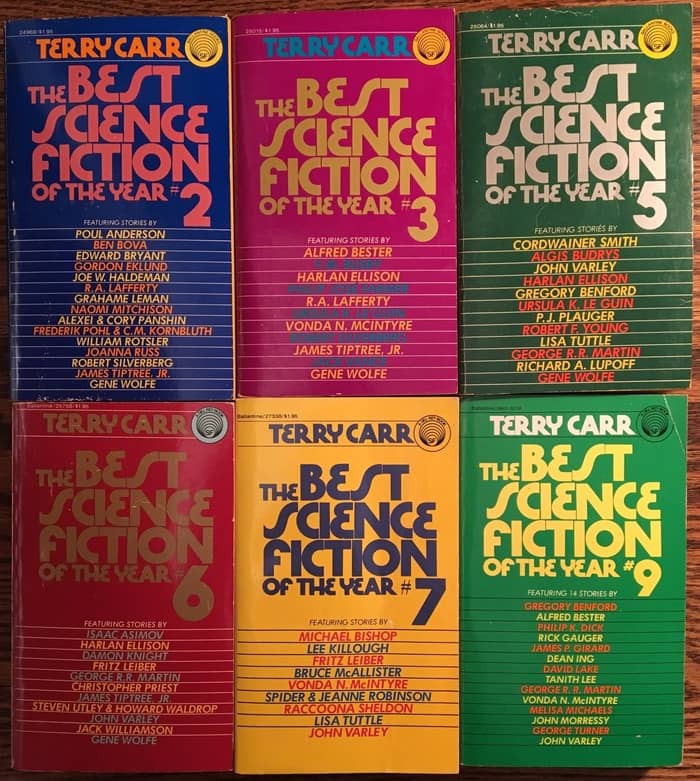
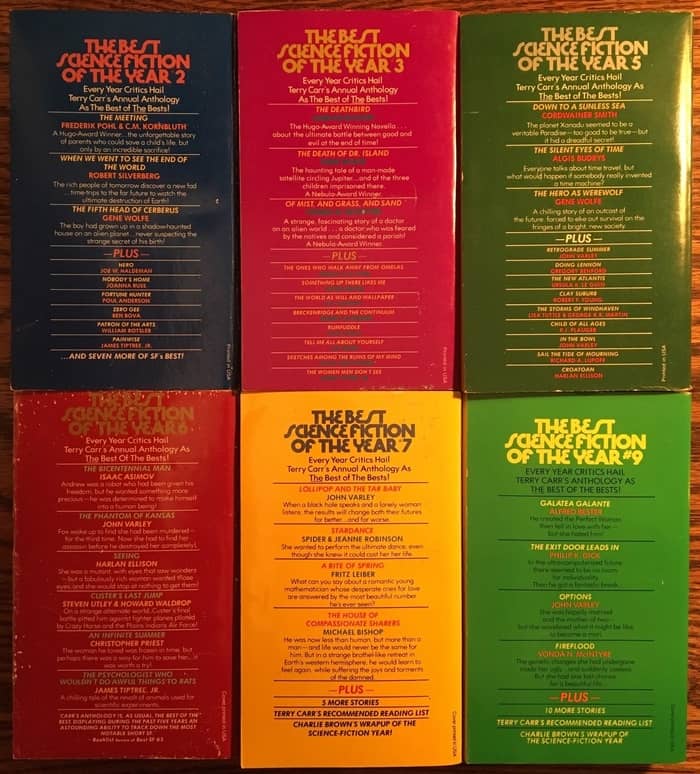
Always good to see those old TOCs — as much for the things we forget (anyone remember Rick Gauger? Or really think that “Galatea Galante” or “Down to a Sunless Sea” was among the best stories of those years, as opposed to stories honored for being by much-admired veterans of the field (one over a decade dead)?)
But there are a lot of hits, including stories perhaps not widely remembered, such as Tanith Lee’s “The Thaw”, or Fritz Leiber’s two excellent stories. And plenty of justly well-remembered stories, such as “I See You” and “The Fifth Head of Cerberus” and “Nobody’s Home”.
Rich,
I agree absolutely. It’s a thrill to see all those forgotten stories, and it’s an even greater thrill to re-read all those I’ve never forgotten.
It’s easy to critique Carr for his misses. Some of the award-winning stories he excluded in these years include:
“The Word for World Is Forest,” Ursula K. Le Guin (Hugo, novella, 1973)
“Goat Song,” Poul Anderson (Hugo, novelette, 1973)
“The Girl Who Was Plugged In,” James Tiptree, Jr. (Hugo, novella, 1974)
“Home is the Hangman,” Roger Zelazny (Hugo & Nebula, novella, 1976)
“San Diego Lightfoot Sue,” Tom Reamy (Nebula, novelette, 1976)
“Catch That Zeppelin!,” Fritz Leiber (Hugo and Nebula, short story, 1976)
“Houston, Houston, Do You Read?.” James Tiptree, Jr. (Hugo, Novella, 1977)
“Ender’s Game,” Orson Scott Card
“Jeffty Is Five,” Harlan Ellison (Hugo & Nebula, short story, 1978)
“Enemy Mine,” Barry B. Longyear (Hugo, novella, 1980)
“The Way of Cross and Dragon,” George R. R. Martin (Hugo, short story, 1980)
But Carr was unapologetic in his choices, and I think he had it right. Anthologies that just collect the winners every year are a dime a dozen. But a series that gather the best SF every year as selected by an editor with a wide range and discerning eye… that’s well worth a read.
I think these books represent the foundations of modern SF. I’m glad they’re still widely available, and I’m proud to showcase them. My only regret is that they’ve long out of print, and there are no digital editions. But that’s okay… that’s why we cherish vintage paperbacks, right?
Oh, no question — the anthologies are better for being his own sometimes idiosyncratic choices. (I cherish the same feeling about my books!)
(Of course, sometimes the award voters get things wrong, too! In fact, I could mention some recent ones … but I won’t.)
It’s part of the game to look back 40 years and see which have survived, which haven’t and should be better remembered, and which really weren’t that good. And it’s also that writers like Gauger and James Girard, to name two whose names don’t ring a bell with me any more, got noticed back them. I imagine if I reread the stories, I’d find them pretty good. (I know Melisa Michaels’ story was pretty good, and she went on to publish several fine novels, though none for some time now, alas.)
Rich,
I note that Terry Carr produced 16 volumes of The Best Science Fiction of the Year between 1972-1987. You are catching up fast, with 9 big volumes of The Year’s Best Science Fiction & Fantasy under your belt — and 15 if you count the six individual volumes of Science Fiction: The Best of the Year and Fantasy: The Best of the Year you produced before that.
(Of course, this neglects the 7 volumes of World’s Best Science Fiction Carr co-edited with Donald A. Wollheim between 1965-1971. … but I figure all those years you produced “Best of the Year” lists at Black Gate square you with Carr there!)
Great article. Just one quibble: “The entire series was published by Ballantine Books.” #9 was actually the last published by Ballantine before it moved to Pocket, then Baen for year, and finally to Tor.
Jason,
Holy cats — you’re absolutely right. That was sloppy; I should have double-checked the publisher for the later volumes.
Good catch, and thanks for the correction! I’ve amended the text above.
By the way, I enjoyed your “Web’s Best Science Fiction” and “Fantasy” volumes… some excellent suggestions! I’m including links below so everyone can check them out:
https://featuredfutures.wordpress.com/2017/12/11/webs-best-fantasy-1-2017-stories/
https://featuredfutures.wordpress.com/2017/12/10/webs-best-science-fiction-1-2017-stories/
I find it interesting to see how even-handed Mr. Carr was when choosing stories from his own original anthology series, Universe, and the other 2 major series, Damon Knight’s Orbit and Robert Silverberg’s New Dimensions. Although I liked Universe slightly more than the other two, Mr. Carr appears to have selected evenly among them.
[…] Leigh Brackett Renaissance? Pulp Trek! A Return to Terry Carr’s Best Science Fiction of the Year Octavia E Butler: Modern Master of […]
Thanks for the kind words and the links, John. I’m glad you enjoyed the posts. 🙂
> Although I liked Universe slightly more than the other two, Mr. Carr appears to have selected evenly among them.
Eugene,
Very true. Carr had to be in competition with Knight and Silverberg, and clearly having the fiction in Universe singled out and recognized had to be important to him. Yet it seems to me that he set all that aside when it came time to decide the Best SF of the Year. Not everyone could do that with as dispassionate an eye as Carr, I think!
[…] Other reviews:1 Charles N. Brown, Isaac Asimov’s Science Fiction Magazine (January/February 1978). John O’Neill, Black Gate […]